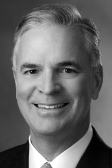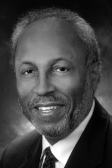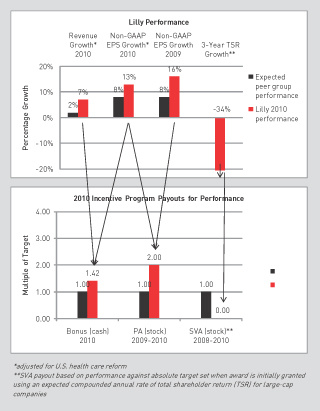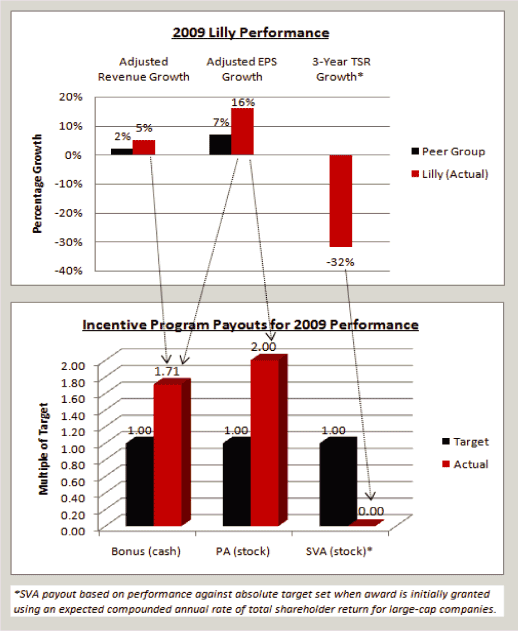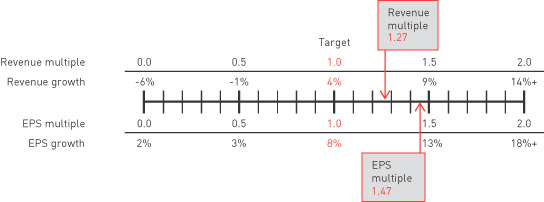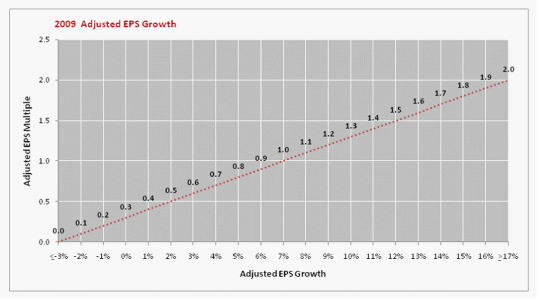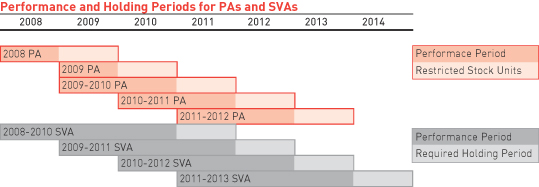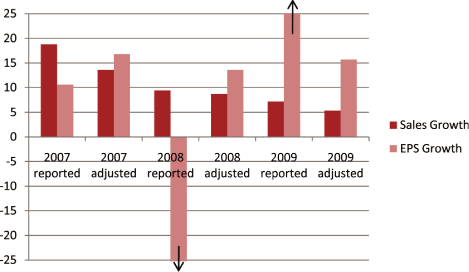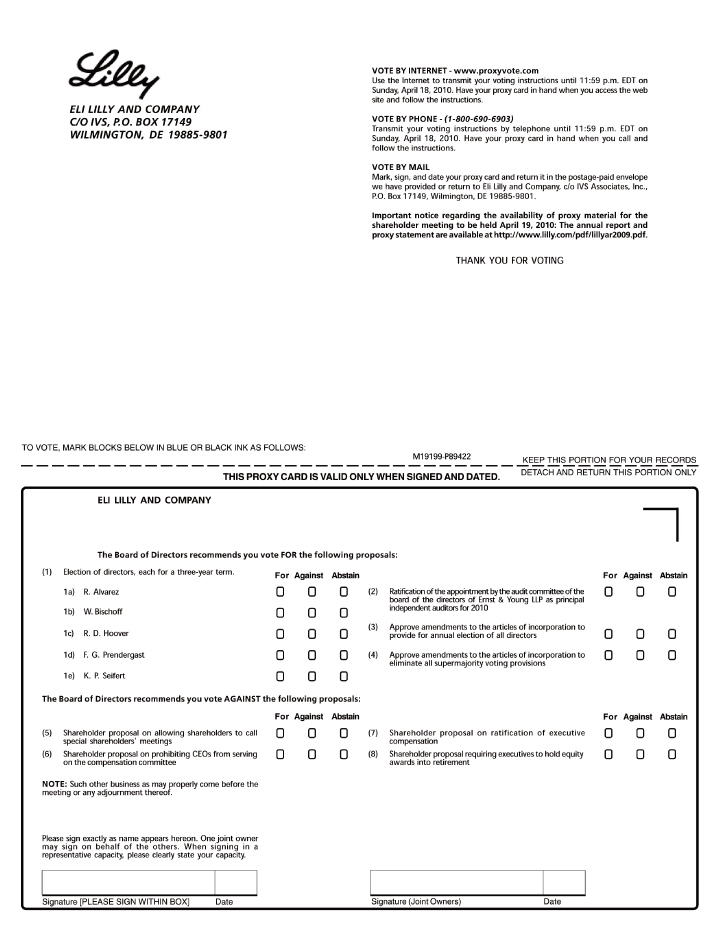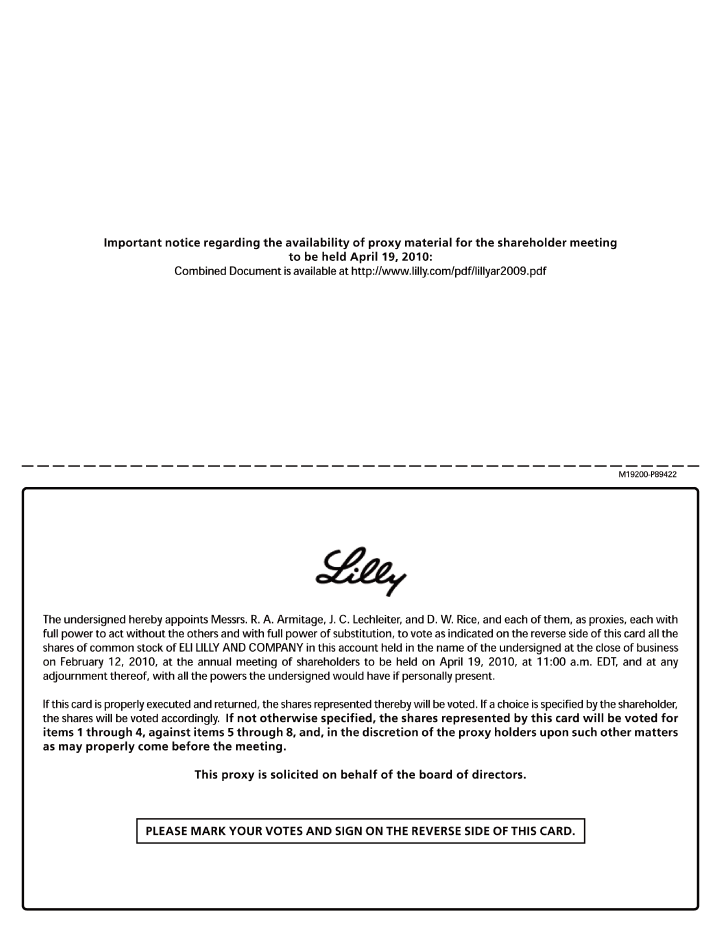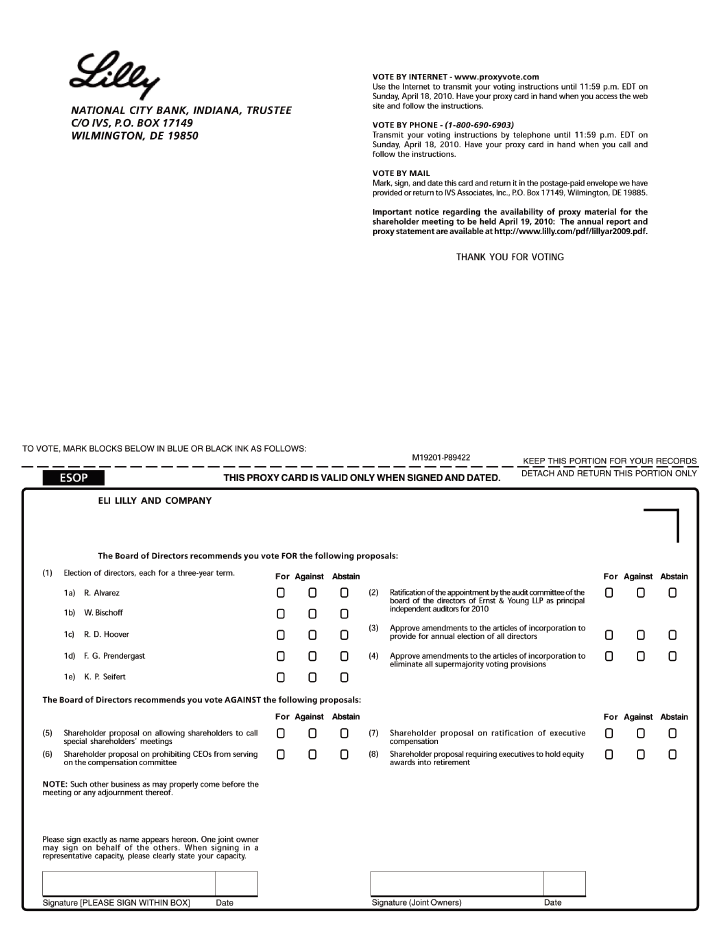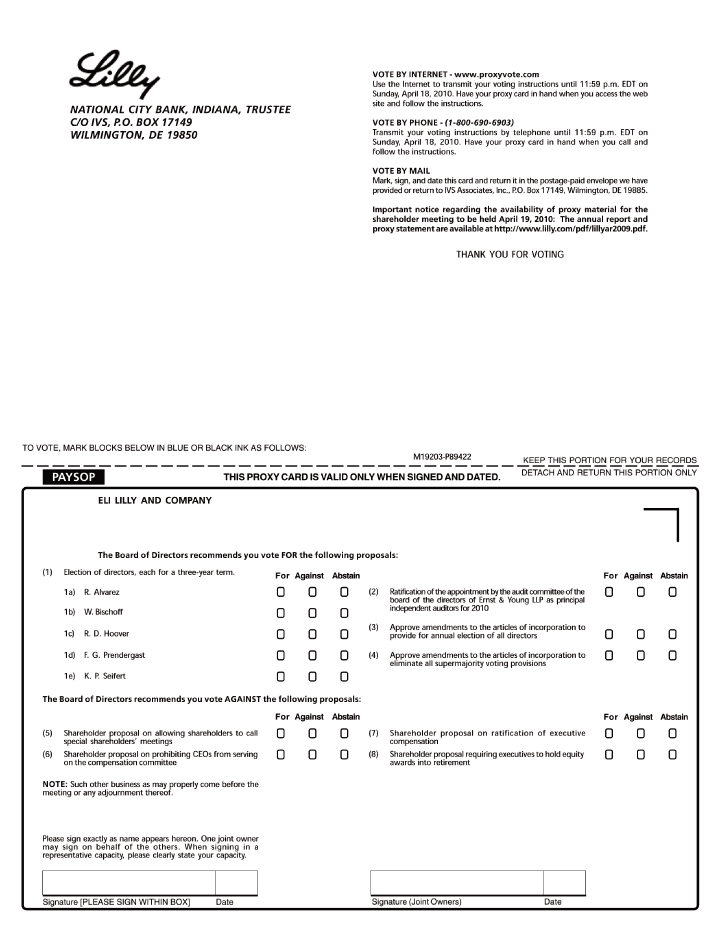Check the appropriate box:
| x | Preliminary Proxy Statement |
| ¨ |
| ¨ |
| ¨ |
| ¨ |
ELI LILLY AND COMPANY
(Name of Registrant as Specified In Its Charter)
(Name of Person(s) Filing Proxy Statement, if other than the Registrant)
Payment of Filing Fee (Check the appropriate box):
| x | |
| ¨ |
| Title of each class of securities to which transaction applies: |
| Aggregate number of securities to which transaction applies: |
| Per unit price or other underlying value of transaction computed pursuant to Exchange Act Rule 0-11 (set forth the amount on which the filing fee is calculated and state how it was determined): |
| Proposed maximum aggregate value of transaction: |
| Total fee paid: |
| ¨ |
| ¨ | |
| Amount Previously Paid: |
| Form, Schedule or Registration Statement No.: |
| Filing Party: |
| Date Filed: |
| SEC 1913 (11-01) | Persons who are to respond to the collection of information contained in this form are not required to respond unless the form displays a currently valid OMB control number. |
March 8, 2010
Dear Shareholder:
You are cordially invited to attend our annual meeting of shareholders on Monday, April 19, 2010,18, 2011, at the Lilly Center Auditorium, Lilly Corporate Center, Indianapolis, Indiana, at 11:00 a.m. EDT.
The notice of meeting and proxy statement that follow describe the business we will consider at the meeting. Your vote is very important. I urge you to vote by mail, by telephone, or on the Internet in order to be certain your shares are represented at the meeting, even if you plan to attend.
Please note our procedures for admission to the meeting described on page 5.
I look forward to seeing you at the meeting.


John C. Lechleiter, Ph.D.
Chairman, President, and Chief Executive Officer
Important notice regarding the availability of proxy materials for the shareholder meeting to be held April 19, 2010:18, 2011: The annual report and proxy statement are available at _________
1
April 19, 2010
The annual meeting of shareholders of Eli Lilly and Company will be held at the Lilly Center Auditorium, Lilly Corporate Center, Indianapolis, Indiana, on Monday, April 19, 2010,18, 2011, at 11:00 a.m. EDT for the following purposes:
to elect four directors of the company to serve three-year terms
to ratify the appointment by the audit committee of Ernst & Young LLP as principal independent auditor for the year 2011
to approve, by non-binding vote, 2010 compensation paid to the company’s named executive officers
to recommend, by non-binding vote, the frequency of future advisory votes on executive compensation
to approve amendments to the articles of incorporation to provide for annual election of all directors
to approve amendments to the articles of incorporation to eliminate all supermajority voting requirements
to approve the executive officer incentive plan.
Shareholders of record at the close of business on February 12, 2010,15, 2011, will be entitled to vote at the meeting and at any adjournment of the meeting.
Attendance at the meeting will be limited to shareholders, those holding proxies from shareholders, and invited guests from the media and financial community. A page at the back of this proxy statementreport contains an admission ticket. If you plan to attend the meeting, please bring this ticket with you.
This combined proxy statement and annual report to shareholders and the proxy votervoting card are being mailed on or about March 8, 2010.
By order of the board of directors,
James B. Lootens
Secretary
March 8, 2010
7, 2011
Indianapolis, Indiana
2
1
Why did I receive this proxy statement?
The board of directors of Eli Lilly and Company is soliciting proxies to be voted at the annual meeting of shareholders (the annual meeting) to be held on Monday, April 19, 2010,18, 2011, and at any adjournment of the annual meeting. When the company asks for your proxy, we must provide you with a proxy statement that contains certain information specified by law.
What will the shareholders vote on at the annual meeting?Eight
Seven items:
election of directors
ratification of the appointment of principal independent auditor
advisory approval of 2010 compensation paid to named executive officers
frequency of future advisory votes on executive compensation
amending the company’s articles of incorporation to provide for annual election of all directors
amending the company’s articles of incorporation to eliminate all supermajority voting requirements
to approve the executive officer incentive plan.
Will there be any other items of business on the agenda?
We do not expect any other items of business because the deadline for shareholder proposals and nominations has already passed. Nonetheless, in case there is an unforeseen need, the accompanying proxy gives discretionary authority to the persons named on the proxy with respect to any other matters that might be brought before the meeting. Those persons intend to vote that proxy in accordance with their best judgment.
Who is entitled to vote?
Shareholders as of the close of business on February 12, 201015, 2011 (the record date) may vote at the annual meeting. You have one vote for each share of common stock you held on the record date, including shares:
held directly in your name as the shareholder of record
held for you in an account with a broker, bank, or other nominee
attributed to your account in The Eli Lilly and Company Employee 401(k) Plan (the 401(k) plan).
What constitutes a quorum?
A majority of the outstanding shares, present or represented by proxy, constitutes a quorum for the annual meeting. As of the record date, _________XXXXXXXXX shares of company common stock were issued and outstanding.
How many votes are required for the approval of each item?
There are differing vote requirements for the various proposals.
The four nominees for director will be elected if the votes cast for the nominee exceed the votes cast against the nominee. Abstentions will not count as votes cast either for or against a nominee.
The following items of business will be approved if the votes cast for the proposal exceed those cast against the proposal:
ratification of |
| — | advisory approval of 2010 executive compensation |
| — | approval of the |
Abstentions will not be counted either for or against these proposals.
The vote on frequency of future advisory votes on executive compensation asks shareholders to express their preference for one of three choices for future advisory votes on executive compensation—every year, every other year, or every three years. Abstentions have the same effect as not expressing a preference.
The management proposals to amend the articles of incorporation to provide for annual election of all directors and to eliminate all supermajority voting requirements require the vote of 80 percent of the outstanding shares. For these items, abstentions have the same effect as a vote against the proposals.
3
2
How do I vote by proxy?
If you are a shareholder of record, you may vote your proxy by any one of the following methods:
By mail.Sign and date each proxy card you receive and return it in the prepaid envelope. Sign your name exactly as it appears on the proxy. If you are signing in a representative capacity (for example, as an attorney-in-fact, executor, administrator, guardian, trustee, or the officer or agent of a corporation or partnership), please indicate your name and your title or capacity. If the stock is held in custody for a minor (for example, under the Uniform Transfers to Minors Act), the custodian should sign, not the minor. If the stock is held in joint ownership, one owner may sign on behalf of all owners. If you return your signed proxy but do not indicate your voting preferences, we will vote on your behalf forwith the election of the nominees for director listed below, for the ratification of the appointment of the independent auditor, for the management proposals on amending the articles of incorporation to provide for annual election of all directors and to eliminate all supermajority voting requirements, and against the shareholder proposals.
If you did not receive a proxy card in the materials you received from the company and you wish to vote by mail rather than by telephone or on the Internet as discussed below, you may request a paper copy of these materials and a proxy card by calling 317-433-5112.If you received an e-mail message notifying you of the electronic availability of these materials, please provide the control number from the e-mail, along with your name and mailing address.
By telephone.Shareholders in the United States, Puerto Rico, and Canada may vote by telephone by following the instructions on your notice or proxy card or, if you received these materials electronically, by following the instructions in the e-mail message that notified you of their availability. Voting by telephone has the same effect as voting by mail. If you vote by telephone, do not return your proxy card. Telephone voting will be available until 11:59 p.m. EDT, April 18, 2010.
On the Internet.You may vote online at www.proxyvote.com. Follow the instructions on your notice or proxy card or, if you received these materials electronically, follow the instructions in the e-mail message that notified you of their availability. Voting on the Internet has the same effect as voting by mail. If you vote on the Internet, do not return your proxy card. Internet voting will be available until 11:59 p.m. EDT, April 18, 2010.
You have the right to revoke your proxy at any time before the meeting by (1)(i) notifying the company’s secretary in writing or (2)(ii) delivering a later-dated proxy by telephone, on the Internet, or by mail. If you are a shareholder of record, you may also revoke your proxy by voting in person at the meeting.
How do I vote shares that are held by my broker?
If you have shares held by a broker or other nominee, you may instruct your broker or other nominee to vote your shares by following instructions that the broker or nominee provides to you. Most brokers offer voting by mail, by telephone, and on the Internet.
How do I vote in person?
If you are a shareholder of record, you may vote your shares in person at the meeting. However, we encourage you to vote by mail, by telephone, or on the Internet even if you plan to attend the meeting.
4
You may instruct the plan trustee on how to vote your shares in the 401(k) plan by mail, by telephone, or on the Internet as described above, except that, if you vote by mail, the card that you use will be a voting instruction card rather than a proxy card.
How many shares in the 401(k) plan can I vote?
You may vote all the shares allocated to your account on the record date. In addition, unless you decline, your vote will also apply to a proportionate number of other shares held in the 401(k) plan for which voting directions are not received. These undirected shares include:
shares credited to the accounts of participants who do not return their voting instructions (except for a small number of shares from a prior stock ownership plan, which can be voted only on the directions of the participants to whose accounts the shares are credited)
shares held in the plan that are not yet credited to individual participants’ accounts.
All participants are named fiduciaries under the terms of the 401(k) plan and under the Employee Retirement Income Security Act (ERISA) for the limited purpose of voting shares credited to their accounts and the portion of undirected shares to which their vote applies. Under ERISA, fiduciaries are required to act prudently in making voting decisions.
If you do not want to have your vote applied to the undirected shares, you should check the box marked “I decline.” Otherwise, the trustee will automatically apply your voting preferences to the undirected shares proportionally with all other participants who elected to have their votes applied in this manner.
3
What happens if I do not vote my 401(k) plan shares?
Your shares will be voted by other plan participants who have elected to have their voting preferences applied proportionally to all shares for which voting instructions are not otherwise received.
What does it mean if I receive more than one proxy card?
It means that you hold shares in more than one account. To ensure that all your shares are voted, sign and return each card. Alternatively, if you vote by telephone or on the Internet, you will need to vote once for each proxy card and voting instruction card you receive.
What does it mean if I did not receive a proxy card?
You may have elected to receive your proxy statement electronically, in which case you should have received an email with directions on how to access the proxy statement and how to vote your shares. You may also have received a letter notifying you that the proxy statement is available online and providing directions on how to access it and how to vote your shares. If you wish to request a paper copy of these materials and a proxy card, please call 317-433-5112.
Who tabulates the votes?
The votes are tabulated by an independent inspector of election, IVS Associates, Inc.
What should I do if I want to attend the annual meeting?
All shareholders as of the record date may attend by presenting the admission ticket that appears at the end of this proxy statement. Please fill it out and bring it with you to the meeting. The meeting will be held at the Lilly Center Auditorium. Please use the Lilly Center entrance to the south of the fountain at the intersection of Delaware and McCarty streets. You will need to pass through security, including a metal detector. Present your ticket to an usher at the meeting.
Parking will be available on a first-come, first-served basis in the garage indicated on the map on page 69.at the end of this report. If you have questions about admittance or parking, you may call 317-433-5112.
How do I contact the board of directors?
You may send written communications to one or more members of the board, addressed to:
Lead Director, Board of Directors
Eli Lilly and Company
c/o Corporate Secretary
Lilly Corporate Center
Indianapolis, Indiana 46285
5
How do I submit a shareholder proposal for the 20112012 annual meeting?
The company’s 20112012 annual meeting is currently scheduled for April 18, 2011.16, 2012. If a shareholder wishes to have a proposal considered for inclusion in next year’s proxy statement, he or she must submit the proposal in writing so that we receive it by November 8, 2010.2011. Proposals should be addressed to the company’s corporate secretary, Lilly Corporate Center, Indianapolis, Indiana 46285. In addition, the company’s bylaws provide that any shareholder wishing to propose any other business at the annual meeting must give the company written notice by November 8, 2010.2011 and no earlier than September 9, 2011. That notice must provide certain other information as described in the bylaws. Copies of the bylaws are available online athttp://investor.lilly.com/governance.cfm or in paper form upon request to the company’s corporate secretary.
Does the company offer an opportunity to receive future proxy materials electronically?
Yes. If you are a shareholder of record or a member of the 401(k) plan, you may, if you wish, receive future proxy statements and annual reports online. If you elect this feature, you will receive an e-mail message notifying you when the materials are available, along with a web address for viewing the materials and instructions for voting by telephone or on the Internet. If you have more than one account, you may receive separate e-mail notifications for each account.
You may sign up for electronic delivery in two ways:
If you vote online as described above, you may sign up for electronic delivery at that time.
You may sign up at any time by visitinghttp://investor.lilly.com/services.cfm.
4
If you received these materials electronically, you do not need to do anything to continue receiving materials electronically in the future.
If you hold your shares in a brokerage account, you may also have the opportunity to receive proxy materials electronically. Please follow the instructions of your broker.
What are the benefits of electronic delivery?
Electronic delivery reduces the company’s printing and mailing costs. It is also a convenient way for you to receive your proxy materials and makes it easy to vote your shares online. If you have shares in more than one account, it is an easy way to avoid receiving duplicate copies of proxy materials.
What are the costs of electronic delivery?
The company charges nothing for electronic delivery. You may, of course, incur the usual expenses associated with Internet access, such as telephone charges or charges from your Internet service provider.
Can I change my mind later?
Yes. You may discontinue electronic delivery at any time. For more information, call 317-433-5112.
What is“householding” “householding”?
We have adopted “householding,”householding, a procedure under which shareholders of record who have the same address and last name and do not receive proxy materials electronically will receive only one copy of our annual report and proxy statement unless one or more of these shareholders notifies us that they wish to continue receiving individual copies. This procedure saves printing and postage costs by reducing duplicative mailings.
6
Beneficial shareholders can request information about householding from their banks, brokers, or other holders of record.
What if I want to receive a paper copy of the annual report and proxy statement?
If you wish to receive a paper copy of the 20092010 annual report and 20102011 proxy statement, or future annual reports and proxy statements, please call 1-800-542-1061 or write to: Householding Department, 51 Mercedes Way, Edgewood, New York 11717. We will deliver the requested documents to you promptly upon your request.
7
5
Directors’ Biographies
Class of 2010
2011
The following fivefour directors’ terms will expire at this year’s annual meeting. Each of these directors has been nominated and is standing for election to serve a term that will expire in 2013.2014. See pages 53-54“Item. 1 Election of this proxy statementDirectors” below for more information.
 | Michael L. Eskew | Age 61 | ||||||
| Director since |
Former Chairman and Chief Executive Officer, United Parcel Service, Inc. Mr. Eskew served as chairman and chief executive officer of United Parcel Service, Inc., from January 2002 until December 2007. He continues to serve on the UPS board of directors. Mr. Eskew began his UPS career in 1972 as an industrial engineering manager and held various positions of increasing responsibility, including time with UPS’s operations in Germany and with UPS Airlines. In 1993, Mr. Eskew was named corporate vice president for industrial engineering. Two years later he became group vice president for engineering. In 1998, he was elected to the UPS board of directors. In 1999, Mr. Eskew was named executive vice president and a year later was given the additional title of vice chairman. He serves as chairman of the board of trustees of The Annie E. Casey Foundation. Mr. Eskew also serves on the boards of 3M Corporation and IBM Corporation. Board Committees: audit (chair) and compensation | ||||||||
| Alfred G. Gilman, M.D., Ph.D. | Age 69 | ||||||
8
| Director since 1995 |
Chief Scientific Officer, Cancer Prevention and Research Institute of Texas Dr. Gilman is the chief scientific officer of the Cancer Prevention and Research Institute of Texas and regental professor of pharmacology emeritus at the University of Texas Southwestern Medical Center at Dallas. Dr. Gilman was on the faculty of the University of Virginia School of Medicine from 1971 to 1981 and was named a professor of pharmacology there in 1977. He previously served as executive vice president for academic affairs and provost of the University of Texas Southwestern Medical Center at Dallas, dean of the University of Texas Southwestern Medical School, and professor of pharmacology at the University of Texas Southwestern Medical Center. He held the Raymond and Ellen Willie Distinguished Chair of Molecular Neuropharmacology; the Nadine and Tom Craddick Distinguished Chair in Medical Science; and the Atticus James Gill, M.D., Chair in Medical Science at the university and was named a regental professor in 1995. He is a director of Regeneron Pharmaceuticals, Inc. Dr. Gilman was a recipient of the Nobel Prize in Physiology or Medicine in 1994. Board Committees: public policy and compliance and science and technology (chair) | ||||||||
 | Karen N. Horn, Ph.D. | Age 67 | ||||||
9
| Director since 1987 |
Retired President, Private Client Services, and Managing Director, Marsh, Inc. Ms. Horn serves as the board’s lead director. She served as president of private client services and managing director of Marsh, Inc. from 1999 until her retirement in 2003. Prior to joining Marsh, she was senior managing director and head of international private banking at Bankers Trust Company; chairman and chief executive officer of Bank One, Cleveland, N.A.; president of the Federal Reserve Bank of Cleveland; treasurer of Bell Telephone Company of Pennsylvania; and vice president of First National Bank of Boston. Ms. Horn serves as director of T. Rowe Price Mutual Funds; Simon Property Group, Inc.; and Norfolk Southern Corporation and vice chairman of the U.S. Russia Foundation. She previously served on the board of Fannie Mae and Georgia-Pacific Corporation. Ms. Horn has been senior managing director of Brock Capital Group since 2004. Board Committees: compensation (chair) and directors and corporate governance | |||||||
6
 | ||||||
John C. Lechleiter, Ph.D. | Age | Director since 2005 | ||||
Chairman, President, and Chief Executive Officer Dr. Lechleiter is chairman, president, and chief executive officer of Eli Lilly and Company. He served as president and chief operating officer from 2005 to 2008. He joined Lilly in 1979 as a senior organic chemist and has held management positions in England and the U.S. He was named vice president of pharmaceutical product development in 1993 and vice president of regulatory affairs in 1994. In 1996, he was named vice president for development and regulatory affairs. Dr. Lechleiter became senior vice president of pharmaceutical products in 1998 and executive vice president for pharmaceutical products and corporate development in 2001. He was named executive vice president for pharmaceutical operations in 2004. He is a member of the American Chemical Society, Business Roundtable, and Business Council. Dr. Lechleiter serves on the boards of Pharmaceutical Research and Manufacturers of America (PhRMA); United Way Worldwide; Xavier University (Cincinnati, Ohio); Life Sciences Foundation; Central Indiana Corporate Partnership; and the 2012 Indianapolis Super Bowl Host Committee. He also serves on the board of Nike, Inc. Board Committees: none | ||||||
Class of 2012
The following four directors will continue in office until 2012.
 | Martin S. Feldstein, Ph.D. | Age 71 | ||||||
| Director since 2002 |
George F. Baker Professor of Economics, Harvard University Dr. Feldstein is the George F. Baker Professor of Economics at Harvard University and president emeritus of the National Bureau of Economic Research. From 1982 through 1984, he served as chairman of the Council of Economic Advisers and President Ronald Reagan’s chief economic adviser. Dr. Feldstein served as president and chief executive officer of the National Bureau of Economic Research from 1977 to 1982 and 1984 to 2008. In 2009, President Obama appointed him to the President’s Economic Recovery Advisory Board. He is a member of the American Philosophical Society, a corresponding fellow of the British Academy, a fellow of the Econometric Society, and a fellow of the National Association for Business Economics. Dr. Feldstein is a trustee of the Council on Foreign Relations and a member of the Trilateral Commission, the Group of 30, the American Academy of Arts and Sciences, and the Council of Academic Advisors of the American Enterprise Institute and past president of the American Economic Association. He previously served on the boards of American International Group, Inc. and HCA Inc. Board Committees: audit, finance, and public policy and compliance (chair) | ||||||||
 | J. Erik Fyrwald | Age 51 | ||||||
| Director since 2005 | ||||||||
Chairman, President, and Chief Executive Officer, Nalco Company Mr. Fyrwald joined Nalco Company (a leading integrated water treatment and process improvement company) as chairman, president, and chief executive officer in February 2008 following a 27-year career at DuPont. From 2003 to 2008, Mr. Fyrwald served as group vice president of the agriculture and nutrition division at DuPont. From 2000 until 2003, he was vice president and general manager of DuPont’s nutrition and health business. In 1999, Mr. Fyrwald was vice president for corporate strategic planning and business development. At DuPont, he held a broad variety of assignments in a number of divisions covering many industries. He has worked in several locations throughout North America and Asia. In addition to serving as chairman of Nalco’s board of directors, Mr. Fyrwald serves as a director of the Society of Chemical Industry, the American Chemistry Council, and the Chicago Public Education Fund, and is a trustee of the Field Museum of Chicago. Board Committees: public policy and compliance and science and technology | ||||||||
10
7
 | Ellen R. Marram | Age 64 | ||||||
| Director since 2002 |
President, The Barnegat Group LLC Ms. Marram is the president of The Barnegat Group LLC, a firm that provides business advisory services. She was a managing director at North Castle Partners, LLC from 2000 to 2005 and is currently an advisor to the firm. From 1993 to 1998, Ms. Marram was president and chief executive officer of Tropicana and the Tropicana Beverage Group. From 1988 to 1993, she was president and chief executive officer of the Nabisco Biscuit Company, the largest operating unit of Nabisco, Inc.; from 1987 to 1988, she was president of Nabisco’s grocery division; and from 1970 to 1986, she held a series of marketing positions at Nabisco/Standard Brands, Johnson & Johnson, and Lever Brothers. Ms. Marram is a member of the board of directors of Ford Motor Company and The New York Times Company, as well as several private companies. She previously served on the board of Cadbury plc. She also serves on the boards of Institute for the Future, New York-Presbyterian Hospital, Lincoln Center Theater, and Families and Work Institute. Board Committees: compensation and directors and corporate governance (chair) | ||||||||
| Douglas R. Oberhelman | Age 58 | ||||||
| Director since 2008 | ||||||||
Chairman and Chief Executive Officer, Caterpillar Inc.
Mr. Oberhelman has been chairman of the board of Caterpillar Inc. since November 2010 and chief executive officer since July 2010. He previously served as vice chairman and chief executive officer-elect of Caterpillar. He joined Caterpillar in 1975 and has held a variety of positions, including senior finance representative based in South America for Caterpillar Americas Co; region finance manager and district manager for the company’s North American commercial division; and managing director and vice general manager for strategic planning at Caterpillar Japan Ltd. Mr. Oberhelman was elected a vice president in 1995, serving as Caterpillar’s chief financial officer from 1995 to November 1998. In 1998, he became vice president with responsibility for the engine products division and he was elected a group president and member of Caterpillar’s executive office in 2002. Mr. Oberhelman serves on the boards of Caterpillar, The Nature Conservancy–Illinois Chapter, the National Association of Manufacturers, the Manufacturing Institute, and the Wetlands America Trust. He previously served on the board of Ameren Corporation.
Board Committees: audit and finance


